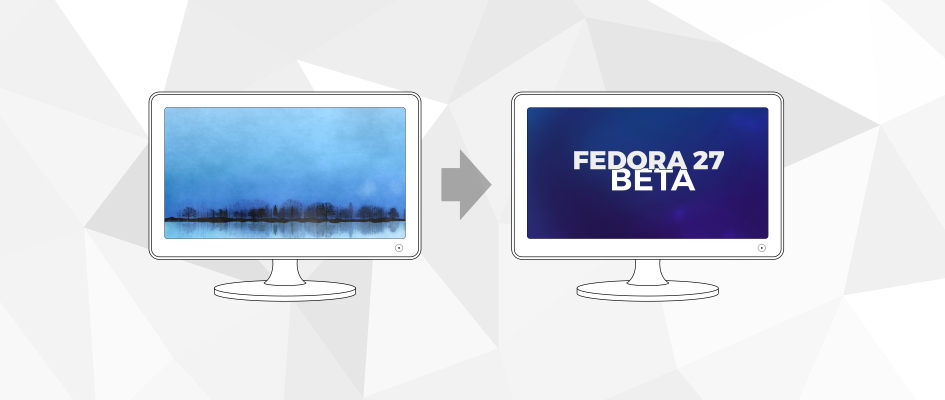In case you missed the news, Fedora 27 Beta was released last week. If you’re running Fedora Workstation, it’s easy to upgrade to the Beta release. Then you can try out some of the new features early. This article explains how.
Some helpful advice
The Fedora 27 Beta is still just what it says it is: a beta. That means some features are still being tuned up before the final release. However, it works well for many users, especially those who are technically skilled. You might be one of them. Before you upgrade, here are some things to keep in mind.
First, back up your user data. While there are no problems currently known that would risk your data, it’s a good idea to have a recent backup for safety.
Second, remember this process downloads all the update data over your internet connection. It will take some time, based on your connection speed. Upgrading the system also requires a reboot, and takes some time to install the updated packages. Don’t perform this operation unless you have time to wait for it to finish.
If you move to the Beta, you’ll receive updates for testing during the prerelease period. When the Beta goes to Final, you’ll receive an update to the fedora-release package. This will shut off the updates-testing stream. Your system will then automatically follow the Fedora 27 stable release. You don’t need to do anything to make this happen.
Upgrading your system
Open a Terminal and type the following command:
gsettings set org.gnome.software show-upgrade-prerelease true
This setting lets the Software application detect the availability of a prerelease, in this case Fedora 27 Beta.
Normally you have to wait for the Software service to refresh its information. However, you can force it to do this in several ways. One is to kill the service and restart it manually:
pkill gnome-software
Now open the Software app. Visit the Updates tab. After a short time, the Software app retrieves fresh information about the prerelease and advertises it to you.
Use the Download Now button to download the upgrade data for Fedora 27 Beta. Follow the prompts to reboot and install the upgrade, which will take some time. When your system restarts after the upgrade, you’ll be running the Fedora 27 Beta.






Daniel
What is the difference between this set of commands and the previous set of commands used for earlier releases? The instructions for 27 Workstation obviously don’t work for a headless server, but what else changes?
Paul W. Frields
@Daniel: The difference here is only in the gsettings that allow Software to detect a prerelease. All else remains the same.
Leslie Satenstein
hi Paul,
I took the alternate approach and installed a clean test verison of the beta 27. My approach is to always preserve /home . and some few other directories (eg. /usr/local/* ) .
From time to time, I scrub that test beta and take the most recent nightly compose.
Is there much difference between the most recent compose version and the “beta with updates” as I have not noticed any?
Vincenzo
“When the Beta goes to Final, you’ll receive an update to the fedora-release package. This will shut off the updates-testing stream. Your system will then automatically follow the Fedora 27 stable release. You don’t need to do anything to make this happen.”
How cool is that : ) exactly the piece of information I was looking for. Thanks!
Tibah Caleb
i am using two operating system on the same computer, windows 10 and fedora 26. will upgrading to fedora 27 beta cause any problem with my computer settings?
Elias Hickman
No! Safe to assume it’s just like any other Linux distro. This is for someone who wants to live on the cutting edge of technology.
Fikoulli
F27 fan;
Many times, I switched to another distro but always back to fedora the day after 🙂
Perfect rpm architecture + ‘cutting edge’ put fedora at the first place (in my opinion).
F27 has some minor bugs, but you can can safely use it.
If you are a beginner, go carefully with the ‘partition selection’ during the installation (anaconda) it’s the one and only ‘difficult’ step.
Enjoy it
Groovy
Yeah, the same for me, but F27 starts to go with flatpack instead of RPM, so good-bye to fedora!
Otavio Brito
I use mate desktop. How can I proceed?
Martin Hvidberg
I trying to go directly from F25 to F27, using this approach. But it says:
[me@localhost ~]$ gsettings set org.gnome.software show-upgrade-prerelease true
No such schema ‘org.gnome.software’
Is this a F25/F26 thing?
Paul W. Frields
@Martin: There is a bug currently preventing F25->F27 upgrades, but that’s not what you’re experiencing. You should check your typing, because the command works properly on my F25 system I just installed here to test.
Chris
I followed the instructions above and I was able to open “software” which then detected Fedora 27 was available, so I clicked to download. But when I click to install, nothing seems to happen. And when I click “Learn More” I get a 404 error saying that https://fedoramag.wpengine.com/whats-new-fedora-27-workstation doesn’t exist. A little more polish would be good for sure! I’m going to reboot and try again. Currently, I’m wondering if some dnf-automatic installs might have messed up the “software” access to dnf.
Chris
Yep, I think there must have been some downloaded and installed rpm’s from dnf-automatic that required a reboot. After the reboot, it appears the OS upgrade from 26 to 27 beta is working properly. I forgot to mention in my previous post that I started the download then went to bed and tried the install in the morning. I don’t want you guys to think there was a problem with the download step, that part worked perfectly the first time.
Chris
After the install and I was able to pull up a terminal again, I checked /etc/redhat-release and it looked good. I also ran dnf update and I was surprised to see 170 packages that needed to be downloaded and updated. Is that because the upgrade from 26 to 27 doesn’t use the latest packages? Or is that because there is something weird with my laptop that prevents it from shutting down and because it can’t shutdown the upgrade from 26 to 27 didn’t go as intended? To me, it looks like the upgrade was successful, and worth it just to get the jellyfish wallpaper!
I was hoping that the update to 27 might fix my shutdown problem, but nope. It looks like the shutdown/reboot process works as intended except for the very last step where it trips the power. Strange.
Paul W. Frields
@Chris: Remember it’s possible there are new updates since you upgraded, because there are still some fixes going in nightly toward the release.
Paul W. Frields
Thanks Chris, you should make sure to conclude any other updates before trying to upgrade.
Moisés
Actually we have some problems with any software, for work seriously and for we take fedora more seriously, although I use fedora for seven years ago and fedora is the only linux system that works in old computers at relatively good speed. I have intalled all dixtros of science complete, And I am happy with fedora. I am proving also CENTOS and SCIENTIFIC LNUX, and OpenSuse.
But Fedora have sufficiently velocity although I have much more programs in its.
But we need some program in finite elements as SALOME or ELMER, for work more seriously, as soon as we need work more seriously with GIS, SAGA GIS and QGIS, we have some problems with some library.
I am securitily to I’ll buy Red Hat Linux, but we need work seriously with some programs, finite elements is one of the programs we need to work well.
I need than the SALOME program will actualice to the last version, before I catch the fedora to the last version.
I see than is very different the form of upgrade fedora to the last version. and I catch note of this in my worknotebook, thank you
Alberto Patino
I upgraded to Fedora 27 from 26 by following console instructions. I only had to remove mono related packages and ring-daemon package. I use nvidia driver and compiz and they work as expected.
Thanks
Aniki
Hello, can you give me any reference (wiki or anythin) that contain step to upgrade F26 to F27 beta using command line? Thank you.